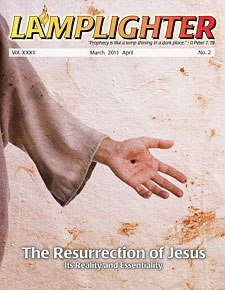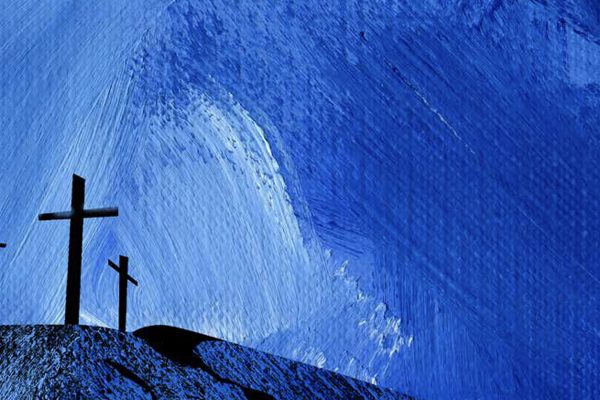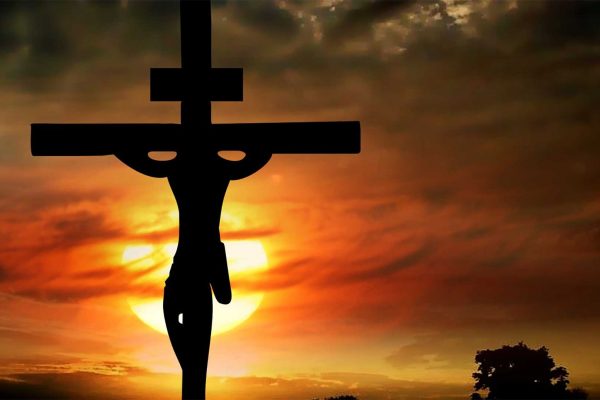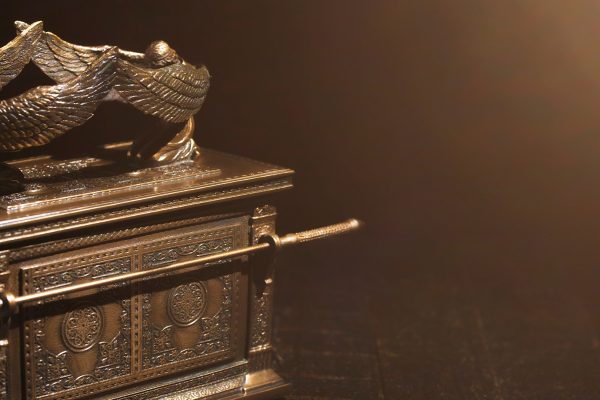A Bible Prophecy Problem Concerning the Resurrection
Did the Resurrection fulfill the prophecy of Jonah?

The most significant prophecy in the Bible concerning the resurrection of Jesus is known as “the prophecy of Jonah.” It is a symbolic prophecy represented by the three days and three nights that Jonah spent in the stomach of a great fish (Jonah 1:17).
Jesus explained the prophetic symbolism of this unique event on an occasion when He rebuked the Pharisees for seeking a “sign” from Him. By a “sign,” they meant a miracle that would validate Jesus’ claim to be the Messiah.
The Prophecy’s Meaning
Jesus took their word and played with it by telling them that the only “sign” they would be given would be “the sign of Jonah.” Jesus then proceeded to explain what He was talking about: “for just as Jonah was three days and three nights in the belly of the sea monster, so shall the Son of Man be three days and three nights in the heart of the earth” (Matthew 12:38-40).
Jesus clearly and distinctly prophesies here, using the example of Jonah, that He will spend three days and three nights in the tomb before His resurrection will occur.
This prophecy, like all Messianic prophecies, had to be fulfilled in the life of Jesus if He truly was the Messiah of God. Jesus emphasized this point Himself after His resurrection when He told His disciples, “All things which are written about Me in the law of Moses and the Prophets and the Psalms must be fulfilled” (Luke 24:44).
The Prophecy vs. Tradition
But was the prophecy of Jonah really fulfilled in the burial experience of Jesus? According to the traditionally accepted chronology of events, it was not!
The traditional chronology places the crucifixion on Friday morning and the burial on late Friday afternoon. It fixes the resurrection on Sunday morning. Thus, according to the traditional view, the body of Jesus was in the tomb only one full day (Saturday) and two full nights (Friday and Saturday). Jesus said His body would be in the tomb three days and three nights.
There have been many attempts to reconcile the problem that is raised here by the divergence between the prophecy and the traditional view of its fulfillment, but all the attempts I have read have always fallen short of producing a true fulfillment of the prophecy. Jesus said all Messianic prophecy had to be fulfilled in Him, and I believe He meant every detail of every Messianic prophecy. Otherwise, it could be argued that He was not the Messiah.
The Source of the Problem
Let’s consider the events in the last week of Jesus’ life to see if we can find some clues that will solve the problem. Perhaps the best place to begin is with the problem itself. It is rooted in Mark 15:42 where it says that the crucifixion took place on “the day of preparation before the Sabbath.”
This verse has led most people to assume that the crucifixion took place on a Friday since the Jewish Sabbath is Saturday. And that assumption has in turn led to the conclusion that the crucifixion had to take place in either 30 or 33 AD because those are the only two years in the general time period of Jesus’ death when the day of preparation (14 Nisan on the Jewish calendar) fell on a Friday.
Peculiarities of the Jewish Calendar
A careful study of Jewish calendar practices will show that the assumption that the day of preparation in the year of Jesus’ death had to fall on a Friday is invalid! Such an assumption is based upon Gentile ignorance about Jewish feast days.
What the Gentile church has failed to recognize over the centuries is that the first day after Passover (15 Nisan) is a feast day, or “high day” because it is the beginning of the Feast of Unleavened Bread. It is therefore considered to be a Sabbath, regardless of which day of the week on which it falls. Read Numbers 28:16-18. Verse 18 clearly indicates that the first day after Passover, Nisan 15, is to be observed as a Sabbath — and so it has been throughout Jewish history to this day.
Now, the Gospel of John makes it clear that the Sabbath after the crucifixion was not a regular Sabbath. Rather, it was a feast day Sabbath, marking the beginning of the Feast of Unleavened Bread. Consider the words of John 19:31 — “The Jews, therefore, because it was the day of preparation, so that the bodies should not remain on the cross on the Sabbath (for that Sabbath was a high day), asked Pilate that their legs might be broken, and that they might be taken away.”
Solving the Problem
Again, the point of all this is that Jesus did not have to be killed on a Friday in order for His crucifixion to precede the Sabbath because there could have been two Sabbaths during the week of His crucifixion, depending on what day of the week the high feast day fell on. If it fell on Saturday, then there was only one Sabbath. But if it fell on another day of the week, as it usually does, there would be two Sabbaths.
Take the year 31 AD for example. In that year the 14th of Nisan, the Passover day on which Jesus would have been crucified, fell on Wednesday, April 25th. The next day, Thursday, would have been the high feast day, and therefore it would have been a Sabbath.
Thus, if Jesus was crucified in the year 31, He would have been crucified on Wednesday and buried that evening before the high feast day Sabbath began. His body would have remained in the tomb for three days (Thursday, Friday and Saturday) and three nights (Wednesday, Thursday and Friday), just as He predicted. That means His resurrection would have taken place on Saturday evening, April 28th. To the Jew, that would place the Lord’s resurrection on Sunday, the first day of the week, because the Jewish day begins at sundown.
The Crucial Clue
There is a clue in the Scriptures that the crucifixion week had two Sabbaths. In Mark 15:47 we are told that Mary Magdalene and Mary the mother of James remained at the tomb after Jesus had been buried. In Mark 16:1 it says that the two of them bought spices to anoint the body of Jesus after the Sabbath was over. But in Luke 23:56 it says they bought the spices before the Sabbath and then rested on the Sabbath before proceeding to the tomb on Sunday morning.
There seems to be only one explanation of the apparent contradiction in these verses. After resting on the high day Sabbath on Thursday, the ladies bought the spices on Friday and then rested again on the regular weekly Sabbath on Saturday before proceeding to the tomb on Sunday morning.
This explains how they could have bought the spices both before and after the Sabbath. They bought them after the high Sabbath on Thursday but before the regular Sabbath on Saturday.
An Amazing Corroboration
A fascinating fact that also indicates that the resurrection may well have occurred in 31 AD is to be found in calculations done by William Whiston, the renowned translator of the writings of Josephus. In a very detailed appendix that he added to his translation, he uses both biblical and extra-biblical sources to determine the date of the last Jubilee year in Israel, before the Roman conquest in 70 AD. His conclusion was that it would have begun in the fall of 27 AD.1
The date of 27 AD most likely marks the beginning of Jesus’ ministry, for His ministry was a symbolic fulfillment of the Jubilee promises. This is indicated by the scripture that Jesus read in the synagogue in Nazareth when He launched His public ministry (Luke 4:16-24 & Isaiah 61:1-2):
The Spirit of the Lord is upon Me,
Because He anointed Me to preach the Gospel to the poor.
He has sent Me to proclaim release to the captives,
And recovery of sight to the blind,
To set free those who are downtrodden,
To proclaim the favorable year of the Lord.
It is commonly agreed that the ministry of Jesus lasted 3 1/2 years. A launching date in the fall of 27 AD to coincide with the beginning of the Jubilee would place His death in the spring of 31 AD — the year in which the Passover week had two Sabbaths.
A Final Problem
Another point of controversy about the resurrection week concerns the nature of the Lord’s last supper with His disciples. The church has traditionally taught that this was the Passover meal. But the scriptures clearly indicate that the meal was eaten the evening before Passover.
Jesus was crucified on the day of preparation for the Passover. In fact, He died at three o’clock in the afternoon at the precise moment that the Passover lambs were being slaughtered for the Passover meal that evening (Matthew 27:45-46).
Jesus and His disciples had eaten their last meal together the evening before Passover. Yet, Jesus referred to His last meal with His disciples as “keeping the Passover” (Matt. 26:18). So, it must have been a Passover meal that was celebrated one evening early.
Professor Harold Hoehner of Dallas Theological Seminary has proposed a solution to this problem.2 He says there is evidence that the Galilean Jews reckoned time differently from the Judean Jews. Whereas the Judean Jews counted a day from sunset to sunset, the Galilean Jews, according to Hoehner, counted a day from sunrise to sunrise. If this is true, then Jesus and His disciples, being Galileans, would have celebrated Passover one evening earlier than their Jewish brethren in the Jerusalem area.
On the other hand, since Jesus knew He was to be sacrificed as the Lamb of God for the sins of the world, He may simply have decided to celebrate Passover one day early so that His death on the cross could coincide precisely with the sacrifice of the Passover lambs the next day.
A Summary of the Order of Events
1) Jesus and His disciples ate the Passover meal on a Tuesday evening (April 24th), one day early, in the Upper Room on Mount Zion.
2) After the Passover meal, Jesus and His disciples departed the Upper Room and walked to the Garden of Gethsemane in the Kidron Valley between the Old City and the Mount of Olives.
3) Jesus was betrayed and arrested early Tuesday evening. His various trials lasted throughout Tuesday night and early Wednesday morning.
4) Jesus was crucified at about 9:00 am on Wednesday morning (April 25th). At noon, darkness filled the land. At about 3:00 pm Jesus died.
5) Jesus was buried on Wednesday about sunset.
6) The two Marys waited until after the high Sabbath on Thursday (April 26th) to purchase the spices for the anointing of Jesus’ body. They bought the spices on Friday (April 27th) and then rested again during the regular Sabbath on Saturday (April 28th) before returning to the tomb on Sunday morning (April 29th).
7) The resurrection of Jesus occurred on Saturday evening (Sunday by Judean reckoning of time). The resurrection was discovered on Sunday morning when the women returned to the tomb.
What Difference Does It Make?
Lest you be tempted to write all this off as much ado about nothing, let me explain why I think it is important. Prophecy and its fulfillment validate Jesus as who He said He was — namely, God in the flesh. Prophecy and its fulfillment also validate the Bible as the inspired Word of God. Prophecy must be fulfilled precisely, not approximately.
The precise fulfillment of prophecy regarding the First Coming of Jesus is our assurance that all the prophecies regarding His Second Coming will also be fulfilled completely to the last detail. God will not forget or overlook anything. He is true to His Word. God keeps His promises. Hallelujah!
Notes
1) William Whiston, The Complete Works of Josephus, with commentary by Paul L. Maier (Grand Rapids, MI: Kregel Publications 1999). Whiston’s calculations of the last Jubilee year in Israel before 70 AD can be found in Appendix Dissertation #5: “Upon the Chronology of Josephus” (page 1067). Whiston graduated from Cambridge in 1690 and succeeded Sir Isaac Newton as Lucasian Professor of Mathematics in 1703. He was a brilliant mathematician, physicist, theologian, and linguist. He lived from 1667 to 1752.
2) Harold W. Hoehner, Chronological Aspects of the Life of Christ (Grand Rapids, MI: Zondervan Publishers, 1978).




